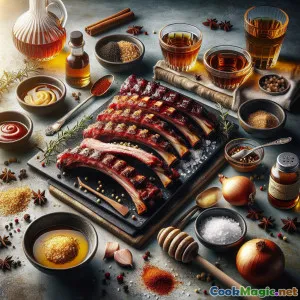
Karamell-Macchiato mit Zuckerhut und samtiger Milchschaum
(Sugarloaf Caramel Macchiato with Silky Foam)
(0 Bewertungen)0
149
Oktober 16, 2025
Problem melden
Zutaten
-
120 grams Demerara-Zucker (oder Piloncillo)
(For a rich, toffee-like 'sugarloaf' caramel; light brown sugar works too)
-
30 ml Wasser
(Helps dissolve sugar evenly for a controlled caramel)
-
90 ml Sahne
(Room temperature; warms the caramel and adds body)
-
20 grams Ungesalzene Butter
(Adds gloss and a soft finish to the caramel)
-
1 tsp Reines Vanilleextrakt
(Stir into caramel off heat for aroma)
-
1 pinch Meersalzflocken
(Balances sweetness; adjust to taste)
-
480 ml Vollmilch
(Chilled; best for stable microfoam)
-
60 ml Frisch gebrühter Espresso
(2 shots total; brew just before serving)
-
0.5 tsp Vanilleschotenpaste
(Fold into milk for a café-style aroma)
-
2 tbsp Schlagsahne
(Dessert-like finish, optional)
-
8 pieces Eiswürfel
(Use for iced version)
-
1 pinch Gemahlene Muskatnuss
(Delicate aromatic garnish)
(For a rich, toffee-like 'sugarloaf' caramel; light brown sugar works too)
(Helps dissolve sugar evenly for a controlled caramel)
(Room temperature; warms the caramel and adds body)
(Adds gloss and a soft finish to the caramel)
(Stir into caramel off heat for aroma)
(Balances sweetness; adjust to taste)
(Chilled; best for stable microfoam)
(2 shots total; brew just before serving)
(Fold into milk for a café-style aroma)
(Dessert-like finish, optional)
(Use for iced version)
(Delicate aromatic garnish)
Nährwerte
- Portionen: 2
- Portionsgröße: 1 mug (12 oz / 355 ml)
- Calories: 280 kcal
- Carbohydrates: 0 g
- Protein: 8 g
- Fat: 10 g
- Fiber: 0 g
- Sugar: 35 g
- Sodium: 150 mg
- Cholesterol: 35 mg
- Calcium: 280 mg
- Iron: 0.3 mg
Anweisungen
-
1 - Start the sugarloaf caramel:
Combine demerara sugar and water in a small saucepan over medium heat. Stir only until the sugar dissolves, then stop stirring and let it simmer. Swirl the pan occasionally until the syrup darkens to a deep amber. Avoid stirring to prevent crystallization.
-
2 - Finish the caramel:
Remove from heat and carefully whisk in warm heavy cream (it will bubble vigorously). Add butter, vanilla extract, and a pinch of sea salt. Whisk until glossy and smooth. Set aside to cool slightly; the caramel will thicken as it cools.
-
3 - Heat and texture the milk:
Warm milk to 60–65°C (140–149°F) using a steam wand or saucepan, then texture to create fine microfoam. If using vanilla bean paste, whisk it into the warm milk.
-
4 - Prep the mugs:
Spoon 1–1.5 tbsp of the sugarloaf caramel into each mug and swirl to coat the base and sides. Reserve additional caramel for drizzling.
-
5 - Assemble the macchiato:
Divide the hot milk between the mugs, holding back a cap of foam. Brew two fresh espresso shots (about 60 ml total) and gently pour one shot through the foam into each mug to ‘mark’ the milk. Spoon foam on top and drizzle a crosshatch of caramel.
-
6 - Garnish and Serve:
Top with whipped cream if desired and a whisper of nutmeg. Serve immediately. For iced: build over ice with cold milk and chilled espresso; skip heating and foam.
Combine demerara sugar and water in a small saucepan over medium heat. Stir only until the sugar dissolves, then stop stirring and let it simmer. Swirl the pan occasionally until the syrup darkens to a deep amber. Avoid stirring to prevent crystallization.
Remove from heat and carefully whisk in warm heavy cream (it will bubble vigorously). Add butter, vanilla extract, and a pinch of sea salt. Whisk until glossy and smooth. Set aside to cool slightly; the caramel will thicken as it cools.
Warm milk to 60–65°C (140–149°F) using a steam wand or saucepan, then texture to create fine microfoam. If using vanilla bean paste, whisk it into the warm milk.
Spoon 1–1.5 tbsp of the sugarloaf caramel into each mug and swirl to coat the base and sides. Reserve additional caramel for drizzling.
Divide the hot milk between the mugs, holding back a cap of foam. Brew two fresh espresso shots (about 60 ml total) and gently pour one shot through the foam into each mug to ‘mark’ the milk. Spoon foam on top and drizzle a crosshatch of caramel.
Top with whipped cream if desired and a whisper of nutmeg. Serve immediately. For iced: build over ice with cold milk and chilled espresso; skip heating and foam.
Mehr über: Karamell-Macchiato mit Zuckerhut und samtiger Milchschaum
Sugarloaf Caramel Macchiato: Story, Craft, and Tips
The Sugarloaf Caramel Macchiato is a cozy, café-style drink you can craft at home, designed to highlight a deep, toffee-forward caramel inspired by the historic sugarloaf. Rather than relying solely on bottled syrup, this recipe shows you how to build a small-batch caramel with demerara (or piloncillo) sugar—a nod to the tall, conical loaves that once defined refined sugar in markets from London to Lisbon. The result is a macchiato that balances velvety milk, bold espresso, and a caramel that feels honest, fragrant, and nuanced.
What makes it unique
- Sugarloaf-inspired caramel: Demerara or piloncillo brings molasses notes and a gentle minerality that white sugar can’t match. The caramel lands somewhere between toffee and butterscotch, with a rounded finish.
- True macchiato structure: Milk and foam are poured first, then the espresso marks the top, creating layered flavors and an aromatic bloom as the crema meets warm foam.
- Textured milk, not just hot milk: The fine microfoam gives the cup a silk-satin mouthfeel and supports the caramel drizzle visually and texturally.
Technique notes
- Caramel control: After dissolving the sugar, stop stirring. Swirl the pan gently and watch for color shifts—from pale honey to copper to deep amber. Pull it off the heat as soon as you see a deep amber tone; the residual heat will carry it a shade darker.
- Temperature is flavor: Keep milk between 60–65°C (140–149°F). Hotter milk can taste flat or scalded and will collapse your microfoam.
- Espresso freshness: Pull your shots right before pouring. A 1:2 brew ratio (e.g., 18 g grounds to 36 g espresso in 25–30 seconds) makes a balanced, sweet shot that can stand up to caramel.
Ingredient spotlight
- Demerara or piloncillo: Their larger crystals and molasses undertones deliver depth. If you only have light brown sugar, it’s a fine substitute—expect lighter caramel notes.
- Vanilla: Adding it at the end preserves aromatics that would otherwise volatilize under heat.
- Salt: Just a pinch lifts the caramel, amplifying both sweetness and complexity.
Variations
- Iced Sugarloaf Caramel Macchiato: Build over ice, use cold milk, and chill the espresso (or brew over ice). Skip steaming; shake milk in a jar for a frothy top.
- Dairy-free: Oat milk yields the plushest foam among non-dairy options, while barista-style almond milk offers a cleaner, nutty counterpoint to caramel.
- Extra bold: Use two shots per mug for a stronger coffee presence; reduce caramel by 1–2 teaspoons to keep balance.
Make-ahead and storage
- Caramel keeps 2–3 weeks refrigerated in a sealed jar. Warm gently (microwave in 5–10 second bursts or a warm-water bath) until pourable. If it separates, whisk vigorously.
Troubleshooting
- Grainy caramel: Likely crystallization. Prevent by washing down pan sides with a wet pastry brush early on, and avoid stirring after dissolution.
- Flat milk: Milk overheated or not enough air in the first seconds of steaming. Introduce air briefly at the start, then focus on whirlpooling to polish the foam.
- Too sweet: Reduce the caramel in the mug to 2 teaspoons and add a touch more espresso.
Serving and presentation
Use prewarmed mugs to maintain temperature. Swirl caramel inside each cup before adding milk; it paints a subtle amber ribbon under the foam. Finish with a neat crosshatch drizzle and a whisper of nutmeg to suggest warmth without overpowering the vanilla.
Cultural notes
Macchiato—Italian for “stained” or “marked”—originated as a way to soften espresso with a dollop of milk foam. The modern caramel macchiato, popularized by American coffeehouses in the late 20th century, flips the script by building on milk first and marking it with espresso. This Sugarloaf variation bridges the Italian concept with a historical nod to sugar commerce, turning a familiar favorite into something with lineage and character.
Final thoughts
This drink is about balance: the bass notes of caramel, the lyrical mid-tones of steamed milk, and the espresso’s bright top note. With a few mindful steps—gentle caramelization, restrained milk temperature, and freshly pulled shots—you’ll pour a macchiato that tastes as composed as it looks. Make it your weekend ritual, and let the sugarloaf caramel become your signature touch.
























